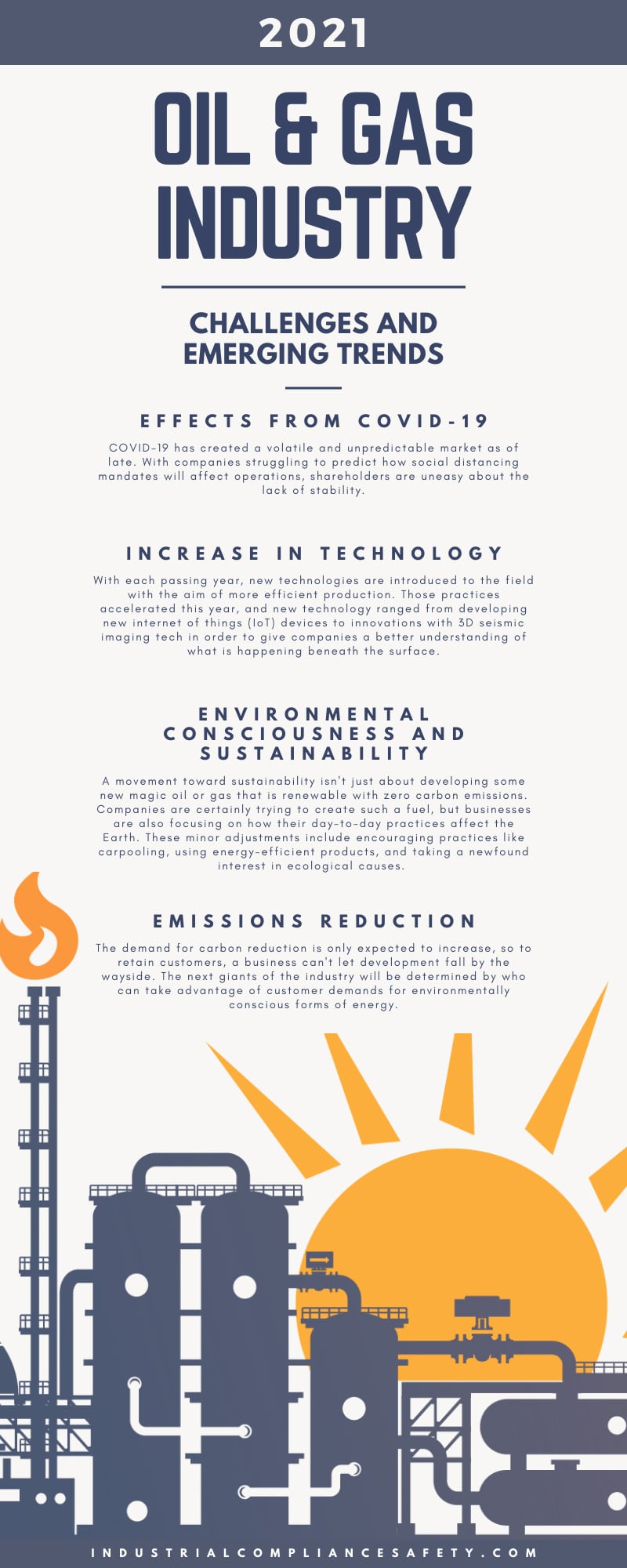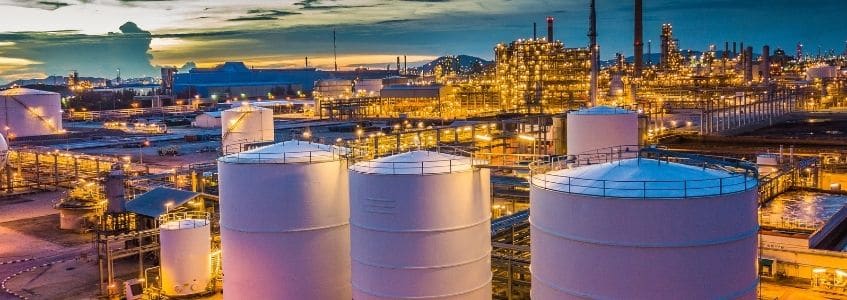As technology and customer expectations change, the goals of the energy business remain relatively unchanged—more, faster, cheaper. COVID-19 saw a rare dip in world emission output as the world went into hibernation. Still, the energy demands will eventually rise to the previous level and continue to increase as the world population grows.
However, despite this rapid growth, consumers still expect suppliers to have a frantic approach to reducing emissions. That means to keep up with the 2021 oil and gas industry challenges and emerging trends, companies must keep pushing innovation to find new best practices that maximize profits and customer satisfaction.
Effects From COVID-19
COVID-19 has created a volatile and unpredictable market as of late. With companies struggling to predict how social distancing mandates will affect operations, shareholders are uneasy about the lack of stability. International partners and procedures have been strained as overseas travel and trade restrictions are constantly changing with the state of the pandemic. Also, social distancing led to a temporary decrease in energy consumption, as people were traveling less and working from home more.
The workforce has also been affected because the number of willing and skilled workers decreased as employees became disillusioned with the industry due to necessary cutbacks caused by the pandemic. Companies may have to find creative solutions when restaffing. That may not be for a while, though, because according to Deloitte, 70 percent of the jobs lost to the pandemic may not come back during 2021. The most damaging effects of COVID-19 on the market are believed to be temporary, and trends should return to normal eventually.
All the effects of COVID-19 haven’t been for the worse, however. Social distancing and a decrease in profits forced the industry to embrace digitization and new technologies. These advancements should be more permanent as companies race each other to find more efficient operating practices.
Increase in Technology
As previously mentioned, the pandemic has caused companies to embrace trends that once looked years away within a matter of months. With each passing year, new technologies are introduced to the field with the aim of more efficient production. Those practices accelerated this year, and new technology ranged from developing new internet of things (IoT) devices to innovations with 3D seismic imaging tech in order to give companies a better understanding of what is happening beneath the surface.
Major players in the industry have been using robotics for a while now to do the more dangerous operations of fracking and other tasks that present high chances of injury. With new developments in robotics, this technology is now becoming a possibility for small companies, too. Robotics not only make your company a safer place to work, but they can cut down on operating costs as they do jobs faster and with a level of precision that humans can’t match.
Skilled vs. Unskilled Workforce
As companies begin to restaff, they will have to choose the type of employees they want to hire. The increase in technology means a reduction in workforce, but that means the retained workers need to be highly skilled and capable of operating advanced machinery.
Skilled workers will be at a premium, and they will most likely be getting competitive offers, making their salaries higher than some businesses will be willing to pay. This competition means that many companies will be looking to hire unskilled workers who they can train specifically for the job. A business will save on salary costs but will lose money in the price of training. Companies should figure out a strategy early on for how they plan to fill these new roles.
Cost Reductions for Contractors and Suppliers
Due to the recent decreases in demand, contractors and suppliers are desperate as ever to find new ways to reduce costs. Companies have to be as pragmatic as possible while they look to shave any operating fat from their books. This is why so many companies had to conduct massive layoffs early in the pandemic. Also, the new technology should lead to operating cost reductions and long-term savings.
The electric power industry had a massive wake-up call with the Texas Power Crisis. The infrastructure was unprepared for winter storms such as the one it received. When the system collapsed, it led to billions of profits for some and the bankrupting of others. Many are making significant investments in their existing infrastructure to avoid any such failures with their own companies. Some are expanding, but the main focus is improving and repairing what companies already have in place.
Compliance in the oil and gas industry with regard to safety requirements is non-negotiable, so many of these infrastructure improvements are focused on improving and restoring precautions. These improvements will make operations safer and should lead to cost reductions as the supply and logistics channels are improved and optimized.
Environmental Consciousness and Sustainability
When the average consumer thinks of environmentally conscious behavior in the energy industry, they probably think of wind and solar energy. This isn’t the only truth, however, as oil and gas companies have been pushing for more sustainable practices in recent years. Clients and consumers now expect companies to do everything in their power to develop new methods of operation that make the environment a chief concern.
A movement toward sustainability isn’t just about developing some new magic oil or gas that is renewable with zero carbon emissions. Companies are certainly trying to create such a fuel, but businesses are also focusing on how their day-to-day practices affect the Earth. These minor adjustments include encouraging practices like carpooling, using energy-efficient products, and taking a newfound interest in ecological causes. Customers now expect these practices, and your company could suffer financially if you leave them unsatisfied.
Emissions Reduction
With the rise of electric cars and other electric alternatives, oil and gas companies are pushing for new uses of oil and gas to create innovative low emission fuels. The demand for carbon reduction is only expected to increase, so to retain customers, a business can’t let development fall by the wayside. The next giants of the industry will be determined by who can take advantage of customer demands for environmentally conscious forms of energy.
This push for emissions reduction should spell an increase in the natural gas sector, which already saw a rise in demand from 2018 to 2019. This growth should only continue as natural gas offers a low-carbon alternative to oil.
The oil and gas companies that will thrive in the near future will be those willing to embrace change and challenge industry norms. As renewable energies become increasingly competitive, it’s essential to find new reasons why oil and gas should be the go-to choice for consumers.
By staying informed on the 2021 oil and gas industry challenges and emerging trends, your business will be better prepared for the future. If you want to make sure your company is up to code and ready to pass any industry safety certifications, reach out to Industrial Safety and Compliance to get a consultation from a trusted expert.






